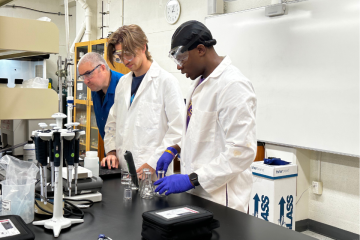Widener’s Anatomy Lab: A Journey to Learn the Body and Human Experience

The first day we walked into Widener’s clinical anatomy lab resides at the forefront of our memories. The smell of formaldehyde, tension in the air, and heaviness that came from knowing that within each enclosed metal dissection table lay not just a body—but someone’s entire life. Their atrophied joints hinted at years full of hard work. Scars, stretch marks and signs of internal damage told us stories of struggles and resilience. As the weeks passed and our dissections deepened, it became clear there was more to learn about the human experience than muscles, bones and ligaments.
When applying to physician assistant, or PA, graduate programs, it was always our hope that we would be granted the unique opportunity to expand our learning in an anatomy lab. Seeing as not all PA programs have access to one, we understand the great privilege that comes with enrolling in Widener’s program. The anatomy lab has shaped our student experience in a multitude of ways. At the most fundamental level, it has enabled us to learn the techniques of cutting and identifying structures of the body—skills that cannot be replicated from reading a textbook alone. Without the anatomy lab, we would not be able to gain and grow these skills that will one day be immensely beneficial to us once we start clinical rotations. Additionally, access to the state-of-the-art clinical facility has allowed us to build a sense of confidence in our abilities not only to develop a deep understanding of the material that we are learning, but also the hands-on aspect of medicine that will soon be essential to us as physician assistants.
Each year, we, along with students from across Widener’s graduate health science programs, gather with our classmates to offer thanks to the families of the donors. During this ceremony, we express our gratitude and reflect on the lasting impact these gifts will have on our careers and the remainder of our lives. With only an estimated 15,000–20,000 individuals in the United States donating their bodies each year for medical education and research, we are deeply aware of how rare and meaningful this opportunity is. We feel truly fortunate to have been entrusted with such an extraordinary gift.
In many ways, these donors were our first patients, and we will always remember them as such. They gave us a profound understanding of anatomy, while also instilling in us lessons of even greater importance—respect every patient and honor the dignity they deserve in both life and death.
Sarah Connors '27, Jordan Li '27, and Vrunda Patel '27 are students in Widener's physician assistant master's program. Widener's clinical anatomy lab is an interdisciplinary lab on campus that serves all graduate health science students. Explore the PA program and all of Widener's graduate health science programs.



